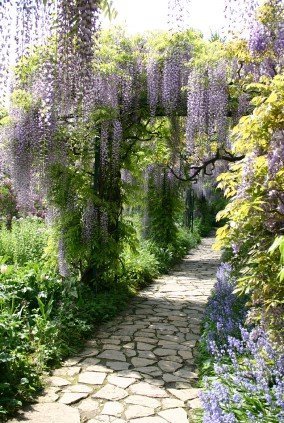
Few plants can rival the dramatic spring beauty of a wisteria vine in full bloom. Despite the showy flowers and delightful scent, wisteria plants have acquired a reputation for being difficult to grow. Don't be fooled. With the right growing conditions and some occasional pruning, wisteria is a beautiful, fast growing vine - and a worthwhile addition to nearly any garden.
Popular for their long, hanging clusters of violet flowers, there are around a dozen wisteria species available to gardeners, including two native to North America. The most common types grown are the Asian species Japanese wisteria (W. floribunda), and Chinese wisteria (W. sinensis).
Japanese wisteria tends to have more vibrant color blooms and Chinese wisteria a sweeter scent. Both species need a large amount of growing space and look very similar in appearance. You can tell the difference between the two by the way they climb. The stems of Japanese wisteria twine around supports in a clockwise direction, while the stems of Chinese wisteria twine in a counterclockwise direction.
Wisteria grows best in zones 3 to 9. Not all varieties are suited to all zones, however, so check carefully to make sure the wisteria you choose is a proven performer where you live. If you lack space (or the ability to erect a sturdy support structure), the smaller American forms of the vine, such as Kentucky wisteria (W. macrostachya) or American wisteria (W. frutescens) don't grow as quickly and can be good substitutes for smaller gardens.
Wisteria will grow in partial shade and marginal soils but performs best in sunny locations (6 or more hours per day) and in moist, fertile soils that drain well. Wisteria needs a large amount of growing space. These plants are vigorous climbers (growing 10 feet or more annually) and are easily capable of climbing to heights of 25 feet.
Once established, the Asian species can become invasive and difficult to get rid of - especially in the east. To help restrain the plant's spreading root system, wisteria can be planted in large containers buried in the ground.
Wisteria needs to be pruned a minimum of twice yearly to keep plants tidy and promote flowering.
You never have to worry about over-building supports for wisteria. Mature vines are heavy and will require ample support. To train young plants to grow on a trellis or arbor, choose an upright stem to serve as the leader and secure this to the support. You can then remove some of the side shoots and train the remaining shoots to grow horizontally across the supports, or simply let them all twine across the supports naturally. Pinch off the main leader when it reaches the desired height.
One of the more frustrating aspects of growing wisteria is waiting for them to reach maturity and then watching them fail to bloom. Here are five common reasons wisteria fail to produce flowers:
Wisteria plants are often started from layered cuttings, but they are also easy to grow from seed.

About The Author: Ellen Brown is an environmental writer and photographer and the owner of Sustainable Media, an environmental media company that specializes in helping businesses and organizations promote eco-friendly products and services. Contact her on the web at http://www.sustainable-media.com
Add your voice! Click below to comment. ThriftyFun is powered by your wisdom!
Be careful where you plant wisteria. Wisteria can be very aggressive and it can topple a fence if left to grow unchecked. The roots also travel underground and can pop up anywhere even on the other side of a fence in a neighbors yard. I pulled mine out 5 years ago and in the spring there are still shoots appearing. It's pretty but not sure it's worth it.
After re reading my short and sweet post on growing Wisteria as a standard, I ran across this well written and very informative article. I can't imagine why anyone would give it a thumbs down. You certainly get a thumbs up from me!
Add your voice! Click below to comment. ThriftyFun is powered by your wisdom!